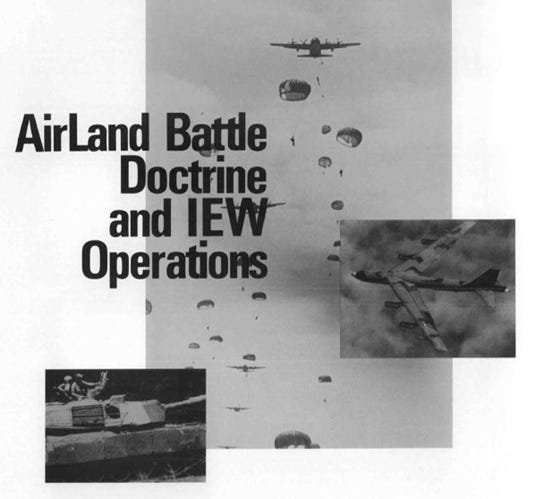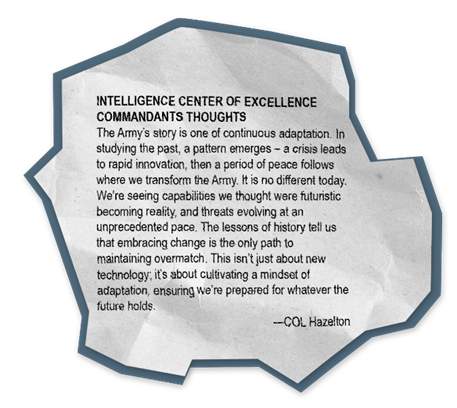Throwback Thursday
Brought to you by MIPB
As the Army evolves toward the 2030 force structure amid turbulence, uncertainty, and modernization, we face challenges that mirror those we’ve faced in the past. MAJ Wayne Hall addressed these issues in an article entitled AirLand Battle Doctrine and Intelligence and Electronic Warfare (IEW) Operations decades ago. Much like the Army of old was going through rapid changes full of frustration and self doubt, we too find ourselves in the midst of rapid change. These concepts, which exemplify the challenges we faced nearly 40 years ago bear unexpected similarities to today’s modernization efforts. Our current dilemma is not unprecedented; indeed, it is part of a recurring cycle of adaptation crucial both to our institution and to a professional army.
Photo courtesy of the author.
MIPB-The forefront and voice of intelligence
The Military Intelligence Professional Bulletin (MIPB) is a unique and valuable collection of professional writing encompassing over 50 years of history. It is the legacy publication of the U.S. Army Intelligence Center of Excellence (USAICoE), documenting the intelligence community’s observations from within the force. It captures what we do well, how to do the things we do better, and our lessons learned—some of which were paid in blood. Over time, however, some of those lessons have fallen by the wayside. MAJ Hall identified that, “The tenets of AirLand Battle doctrine are dependent on timely, accurate intelligence and effective IEW operations.”[i] The same stresses he identified then are the same struggles that the Intelligence War Fighting Function face today.
Photo courtesy of the author.
Everything old is new again.
The U.S. Army has always been an organization in transition, continually adapting to new technologies, evolving threats, and shifting strategic landscapes. This isn’t a novel situation: even back in MAJ Hall’s day, analysis recognized the difficulties of achieving certainty on a battlefield contested by a thinking enemy, compounded by the inherent limitations of human perception. That is why we continue to update our doctrine, realign force restructure, and modernize.
The Army of 1986 was worried about deep sensing and the timeliness of intelligence. They prioritized agility and speed to ensure rapid operations, staying ahead of the enemy’s decision-making process. Today, as we integrate unprecedented capabilities, like artificial intelligence and navigating an increasingly complex global environment, we’re once again facing significant change to maintain an advantage over our adversaries. This isn’t a simple matter of adopting novel new tools; instead, we’re undergoing a fundamental shift in how we organize, train, and fight. We’re witnessing a force restructure designed to meet the challenges of large-scale combat operations against near-peer adversaries. A prime example is the Military Intelligence Corps’ ongoing transformation, including the creation of IEW Battalions—a significant restructuring aimed at enhancing our ability to deliver timely and actionable intelligence at all echelons. It is important to note that the Army went through this exact change decades ago and leaders had the same trepidation then as we do now.
This restructuring also necessitates changes to military occupational specialties (MOSs) to align skillsets with emerging requirements. These changes, while potentially disruptive in the short term, are essential to building a more capable and adaptable force. The Army is actively reevaluating and updating MOS qualifications to ensure we put the right personnel with the right skills in the right places.
We have transitioned before and are better because of it.
It’s important to acknowledge that we are naturally resistant to change, not just as humans, but as an institution. This resistance isn’t necessarily counterproductive; it stems from a desire for stability, predictability, and a proven path to success. However, clinging rigidly to established practices in the face of evolving threats is a path to obsolescence. Our adversaries are not static; to maintain overmatch, we must, like Janus, consider the past as we look to the future and embrace adaptation and innovation.
This process will inevitably involve uncertainty—just as it always has. It’s perfectly acceptable (and, indeed, completely expected) to operate in an environment where not all the answers are clear. MAJ Hall identified that human beings want facts before they act. He identified that this is especially true when the stakes are high and that predicting facts was as accurate in his day as it was more than 180 years before his article was published when the Army was first created.[i] The demand for actionable intelligence is just as high today as it was back then. The modern operational environment is characterized by ambiguity and volatility. The key is to maintain a bias for action, learn consistently from both successes and failures, and strive for continuous improvement in effectiveness.
Conclusion
Just because change can be difficult does not take away the fact that change is often good. Change is nothing new to the Army and allows us to remain competitive with our peers. To succeed, the intelligence community (and, indeed, the entire Army enterprise) must recognize that while the principles of conflict are enduring, adaptation is vital. It’s not enough simply to recall the past; we must deliberately apply its lessons and constantly update our approach to remain effective against evolving threats.
MAJ David Sides is a Military Intelligence Officer and the current Senior Military Editor-in-Chief of the MI Professional Bulletin (MIPB).
[1] Hall, “AirLand Battle Doctrine and IEW Operations,” Military Intelligence Professional Bulletin (July–September 1986): 10–15, https://mipb.ikn.army.mil/1986/.
[1] Hall, “AirLand Battle Doctrine and IEW Operations,”


